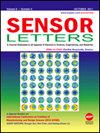Electrochemical Sensor for Acetaminophen Based on a Poly(diphenylamine sulfonic acid) Modified Sensor
引用次数: 0
Abstract
A sensitive and simple modified sensor was prepared by electrodeposition of diphenylamine sulfonic acid (DPSA) to the glassy carbon electrode surface by cyclic voltammetry (CV) technique. The electrooxidation of Acetaminophen (AC) was accomplished by CV and differential pulse voltammetry at poly(DPSA) modified sensor. As a result of the findings, the current values were enhanced and both substances were separated at the modified sensor compared to the bare electrode. There was linearly between the oxidation current and concentration of AC from 0.0 to 100 μM in phospate buffer solution at pH 7.0. The limit of detection was 3.0 nM and the sensitivity was 0.4108 μA/μM. The determination of AC was successfully and satisfactorily carried out in real samples such as human blood serum and urine at the poly(DPSA) sensor. To the best knowledge of this work, this is the first study that detect the AC in the presence of ascorbic acid at poly(DPSA) sensor in the literature.基于聚二苯胺磺酸修饰的对乙酰氨基酚电化学传感器
采用循环伏安法(CV)将二苯胺磺酸(DPSA)电沉积在玻碳电极表面,制备了一种灵敏、简便的改性传感器。在聚(DPSA)修饰的传感器上,利用CV和差分脉冲伏安法完成了对乙酰氨基酚(AC)的电氧化。由于这些发现,与裸电极相比,电流值得到了增强,两种物质在改进的传感器上被分离。在pH 7.0的磷酸盐缓冲溶液中,氧化电流与AC浓度在0.0 ~ 100 μM范围内呈线性关系。检测限为3.0 nM,灵敏度为0.4108 μA/μM。用聚(DPSA)传感器对人血清和尿液等实际样品进行了AC的测定,结果满意。据本工作所知,这是文献中第一个在聚(DPSA)传感器上检测抗坏血酸存在下AC的研究。
本文章由计算机程序翻译,如有差异,请以英文原文为准。
求助全文
约1分钟内获得全文
求助全文
来源期刊

Sensor Letters
工程技术-电化学
自引率
0.00%
发文量
0
审稿时长
6 months
期刊介绍:
The growing interest and activity in the field of sensor technologies requires a forum for rapid dissemination of important results: Sensor Letters is that forum. Sensor Letters offers scientists, engineers and medical experts timely, peer-reviewed research on sensor science and technology of the highest quality. Sensor Letters publish original rapid communications, full papers and timely state-of-the-art reviews encompassing the fundamental and applied research on sensor science and technology in all fields of science, engineering, and medicine. Highest priority will be given to short communications reporting important new scientific and technological findings.
 求助内容:
求助内容: 应助结果提醒方式:
应助结果提醒方式:


